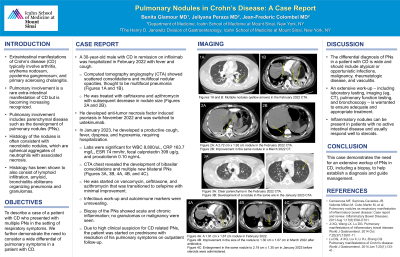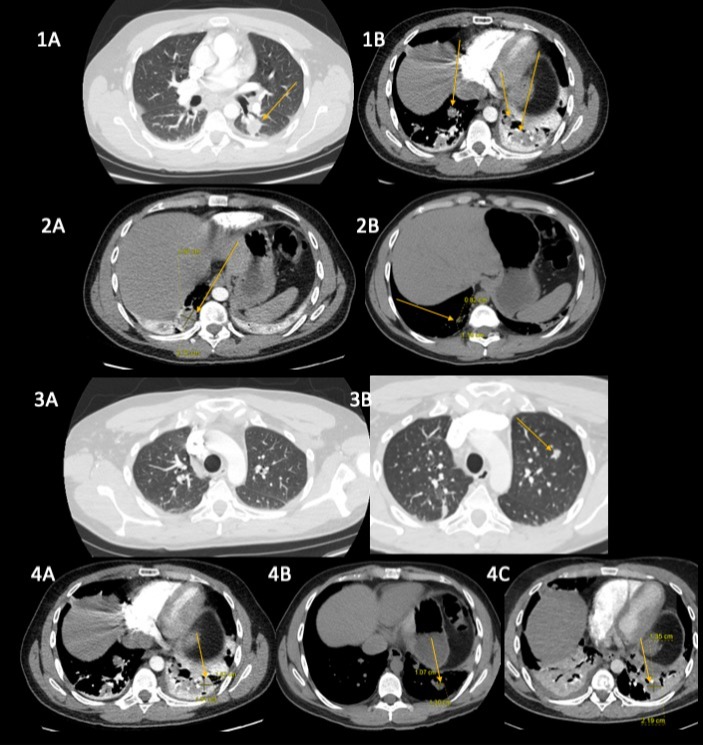Tuesday Poster Session
Category: IBD
P3666 - Pulmonary Nodules in Crohn’s Disease: A Case Report
Tuesday, October 24, 2023
10:30 AM - 4:00 PM PT
Location: Exhibit Hall

Has Audio

Benita K. Glamour, MD
Mount Sinai Hospital
New York, NY
Presenting Author(s)
Benita K. Glamour, MD1, Jellyana Peraza, MD1, Jean-Frederic Colombel, MD2
1Mount Sinai Hospital, New York, NY; 2Icahn School of Medicine at Mount Sinai, New York, NY
Introduction: Pulmonary manifestations of Crohn’s disease (CD) are increasingly recognized and can involve the airways (bronchitis, bronchiectasis) and parenchyma (alveolitis, fibrosis). Here we report a case of a patient with CD who presented with multiple pulmonary nodules (PNs).
Case Description/Methods: A 30-year-old man with CD in remission on infliximab was hospitalized in 2/2022 for fever and cough. Computed tomography angiography (CTA) chest showed scattered consolidations and multifocal nodular opacities, thought to be multifocal pneumonia. He was treated with ceftriaxone and azithromycin with subsequent decrease in nodule size. The patient developed anti-tumor necrosis factor induced psoriasis in 11/2022 and was switched to ustekinumab. His disease course was further complicated by another episode of productive cough, fever, dyspnea, and hypoxemia, requiring hospitalization in 1/2023. Labs were significant for WBC 8,800 /uL, CRP 163.7 mg/L, ESR 74 mm/hr, fecal calprotectin 399 ug/g, and procalcitonin 0.10 ng/mL. CTA chest revealed the development of bibasilar consolidations and multiple new bilateral PNs. He was started on vancomycin, ceftriaxone, and azithromycin that was transitioned to cefepime with minimal improvement. Infectious work-up and autoimmune markers were unrevealing. Biopsy of the PNs showed acute and chronic inflammation; no granulomas or malignancy were seen. Due to high clinical suspicion for CD related PNs, the patient was started on prednisone with resolution of his pulmonary symptoms on outpatient follow-up.
Discussion: PNs are a rare extra-intestinal manifestation of CD. Histology is most often consistent with necrobiotic nodules, spherical aggregates of neutrophils with associated necrosis, however, lymphoid infiltration, amyloid, bronchiolitis obliterans organizing pneumonia and granulomas have also been seen. The differential diagnosis should include atypical or opportunistic infections, malignancy, rheumatologic disease, and vasculitis. Inflammatory nodules can be present in patients with no active intestinal disease and usually respond well to steroids. Our observation illustrates the need for biopsy of PNs in CD to help establish diagnosis and guide management.
Lu DG, Ji XQ, Liu X, Li HJ, Zhang CQ. Pulmonary manifestations of Crohn's disease. World J Gastroenterol. 2014 Jan 7;20(1):133-41.
Carrascosa MF, et al. Pulmonary nodules as respiratory manifestation of inflammatory bowel disease: Case report and review. Inflammatory Bowel Diseases, 2011 Aug 1:17(8):E99–E101.

Disclosures:
Benita K. Glamour, MD1, Jellyana Peraza, MD1, Jean-Frederic Colombel, MD2. P3666 - Pulmonary Nodules in Crohn’s Disease: A Case Report, ACG 2023 Annual Scientific Meeting Abstracts. Vancouver, BC, Canada: American College of Gastroenterology.
1Mount Sinai Hospital, New York, NY; 2Icahn School of Medicine at Mount Sinai, New York, NY
Introduction: Pulmonary manifestations of Crohn’s disease (CD) are increasingly recognized and can involve the airways (bronchitis, bronchiectasis) and parenchyma (alveolitis, fibrosis). Here we report a case of a patient with CD who presented with multiple pulmonary nodules (PNs).
Case Description/Methods: A 30-year-old man with CD in remission on infliximab was hospitalized in 2/2022 for fever and cough. Computed tomography angiography (CTA) chest showed scattered consolidations and multifocal nodular opacities, thought to be multifocal pneumonia. He was treated with ceftriaxone and azithromycin with subsequent decrease in nodule size. The patient developed anti-tumor necrosis factor induced psoriasis in 11/2022 and was switched to ustekinumab. His disease course was further complicated by another episode of productive cough, fever, dyspnea, and hypoxemia, requiring hospitalization in 1/2023. Labs were significant for WBC 8,800 /uL, CRP 163.7 mg/L, ESR 74 mm/hr, fecal calprotectin 399 ug/g, and procalcitonin 0.10 ng/mL. CTA chest revealed the development of bibasilar consolidations and multiple new bilateral PNs. He was started on vancomycin, ceftriaxone, and azithromycin that was transitioned to cefepime with minimal improvement. Infectious work-up and autoimmune markers were unrevealing. Biopsy of the PNs showed acute and chronic inflammation; no granulomas or malignancy were seen. Due to high clinical suspicion for CD related PNs, the patient was started on prednisone with resolution of his pulmonary symptoms on outpatient follow-up.
Discussion: PNs are a rare extra-intestinal manifestation of CD. Histology is most often consistent with necrobiotic nodules, spherical aggregates of neutrophils with associated necrosis, however, lymphoid infiltration, amyloid, bronchiolitis obliterans organizing pneumonia and granulomas have also been seen. The differential diagnosis should include atypical or opportunistic infections, malignancy, rheumatologic disease, and vasculitis. Inflammatory nodules can be present in patients with no active intestinal disease and usually respond well to steroids. Our observation illustrates the need for biopsy of PNs in CD to help establish diagnosis and guide management.
Lu DG, Ji XQ, Liu X, Li HJ, Zhang CQ. Pulmonary manifestations of Crohn's disease. World J Gastroenterol. 2014 Jan 7;20(1):133-41.
Carrascosa MF, et al. Pulmonary nodules as respiratory manifestation of inflammatory bowel disease: Case report and review. Inflammatory Bowel Diseases, 2011 Aug 1:17(8):E99–E101.

Figure: Figures 1a) and b) picture multiple nodules in the 2/2022 CTA. Figure 2a) demonstrates a 2.72 cm x 1.92 cm nodule in the 2/2022 CTA whereas b) demonstrates improvement in the same nodule in a 3/2022 computed tomography (CT) measuring 0.82 cm x 1.18 cm after antibiotics. Figure 3a) shows clear parenchyma in 2/2022 whereas b) demonstrates the development of a nodule in the same area in the 1/2023 CTA. Figure 4a) demonstrates a 1.91 cm x 1.67 cm nodule in 2/2022, b) shows improvement in the size of the nodule to 1.30 cm x 1.07 cm in 3/2022 after antibiotics, and c) shows enlargement in the same nodule to 2.19 cm x 1.35 cm in 1/2023 before steroids were administered.
Disclosures:
Benita Glamour indicated no relevant financial relationships.
Jellyana Peraza indicated no relevant financial relationships.
Jean-Frederic Colombel: AbbVie – Consultant, Grant/Research Support, lecture fees. Allergan – Consultant, Speakers Bureau. Amgen – Consultant, Speakers Bureau. AnaptysBio – Consultant. Arena Pharmaceuticals – Consultant. Boehringer Ingelheim – Consultant. Bristol Myers Squibb – Consultant, Grant/Research Support, Speakers Bureau. Celgene Corporation – Consultant. Celltrion – Consultant. Eli Lilly – Consultant. Enterome – Consultant. Ferring Pharmaceuticals – Consultant, Speakers Bureau. Galmed Research – Consultant. Genentech (Roche) – Consultant. Gilead – Consultant. Glaxo Smith Kline – Consultant. Immunic – Consultant. Imtbio – Consultant. Inotrem – Consultant. Intestinal Biotech Development – Stock Options. Invea – Consultant. Ipsen – Consultant. Iterative Scopes – Consultant. Janssen Pharmaceuticals – Consultant, Grant/Research Support. Kaleido Biosciences – Consultant. Landos – Consultant. LimmaTech Biologics AG – Consultant. Medimmune – Consultant. Merck – Consultant. Microba Life Science – Consultant. Novartis – Consultant. O Mass – Consultant. Otsuka Pharmaceutical – Consultant. Pfizer – Consultant. Prometheus – Consultant. Protagonis Therapeutics – Consultant. Sanofi – Consultant. Seres – Consultant. Shire – Consultant, Speakers Bureau. Takeda – Consultant, Grant/Research Support, lecture fees. Teva – Consultant. TiGenix – Consultant. Viela Bio – Consultant. Vifor – Consultant.
Benita K. Glamour, MD1, Jellyana Peraza, MD1, Jean-Frederic Colombel, MD2. P3666 - Pulmonary Nodules in Crohn’s Disease: A Case Report, ACG 2023 Annual Scientific Meeting Abstracts. Vancouver, BC, Canada: American College of Gastroenterology.
